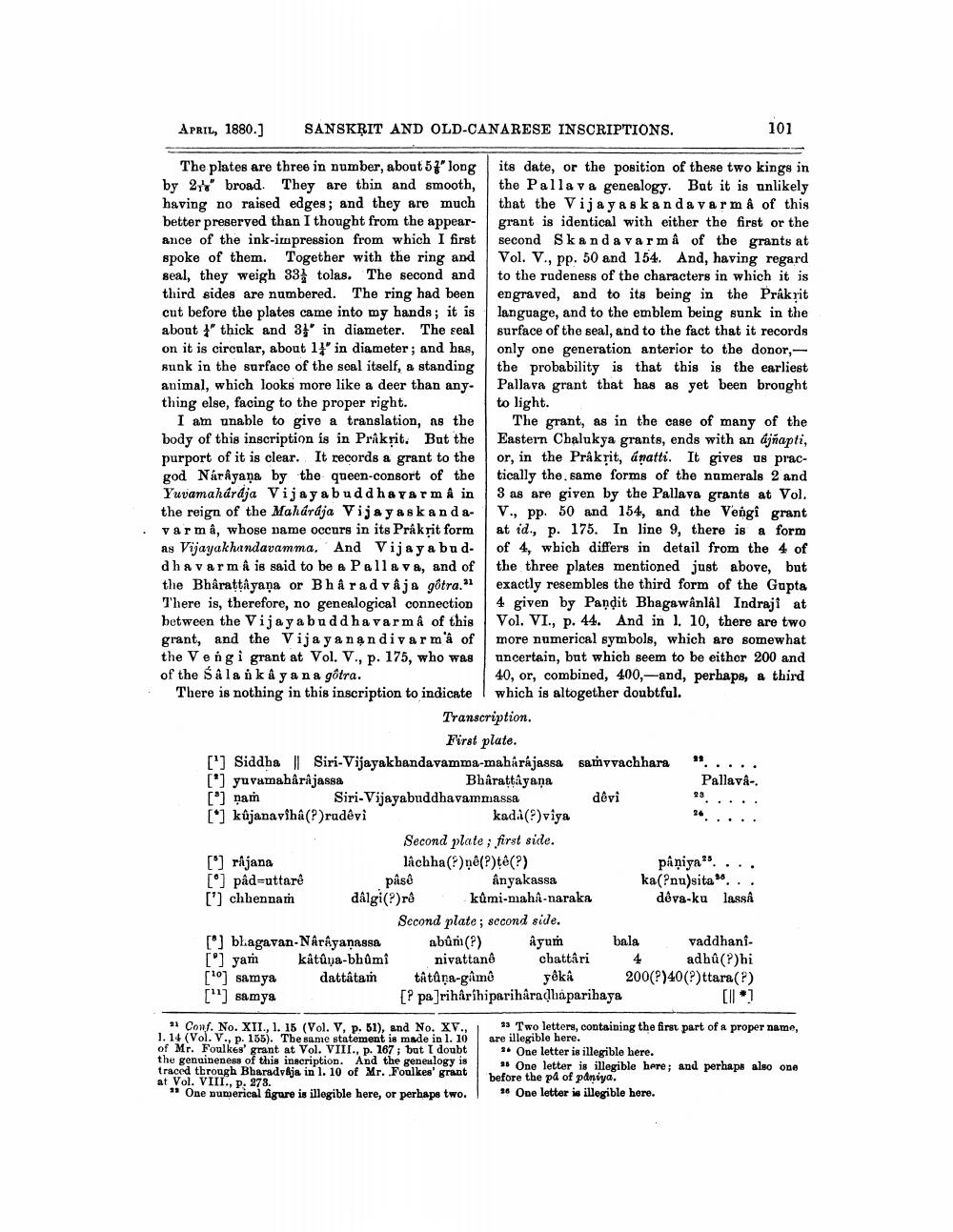________________
APRIL, 1880.]
SANSKRIT AND OLD-CANARESE INSCRIPTIONS.
101
The plates are three in number, about 57" long its date, or the position of these two kings in by 270" broad. They are thin and smooth, the Palla va genealogy. But it is unlikely having no raised edges; and they are much that the Vijayakanda varm & of this better preserved than I thought from the appear- grant is identical with either the first or the ance of the ink-impression from which I first second Skand a varma of the grants at spoke of them. Together with the ring and Vol. V., pp. 50 and 154. And, having regard seal, they weigh 33; tolas. The second and to the rudeness of the characters in which it is third sides are numbered. The ring had been engraved, and to its being in the Prakrit cut before the plates came into my hands; it is language, and to the emblem being sunk in the about thick and 31' in diameter. The seal surface of the seal, and to the fact that it records on it is circular, about 1' in diameter; and has, only one generation anterior to the donor,sunk in the surface of the seal itself, a standing the probability is that this is the earliest animal, which looks more like a deer than any. Pallava grant that has as yet been brought thing else, facing to the proper right.
to light. I am unable to give a translation, as the The grant, as in the case of many of the body of this inscription is in Prakrit. But the Eastern Chalukya grants, ends with an djñapti, purport of it is clear. It records a grant to the or, in the Prakrit, ánatti. It gives us pracgod Nárayana by the queen-consort of the tically the same forms of the numerals 2 and Yuvamahárdja Vijayabuddhayarm å in 3 as are given by the Pallava grants at Vol. the reign of the Mahárája Vijayaskanda- V., pp. 50 and 154, and the Vergi grant varma, whose name occurs in its Prakrit form at id., p. 175. In line 9, there is a form as Vijayakhandavamma. And Vijay a bud. of 4, which differs in detail from the 4 of dha varma is said to be a Palla va, and of the three plates mentioned just above, but the Bhârattayaņa or Bharad vâja gôtra." exactly resembles the third form of the Gupta There is, therefore, no genealogical connection 4 given by Pandit Bhagawanlal Indraji at between the Vijayabaddha varma of this Vol. VI., p. 44. And in 1. 10, there are two grant, and the Vijaya nandivarma of more numerical symbols, which are somewhat the Veng i grant at Vol. V., p. 175, who was uncertain, but which seem to be either 200 and of the Sala i ka ya na gôtra.
40, or, combined, 400,-and, perhaps, a third There is nothing in this inscription to indicate which is altogether doubtful.
Transcription.
First plate. ['] Siddha Siri-Vijayakhandavamma-maharajassa samvvachhara "..... [*] yuvamahârâjassa
Bhârattayaņa
Pallava['] nam Siri-Vijayabuddhavammassa
devi
23.... [*] kûjanaviha(?)radevi
kada(?)viya
34..... Second plate; first side. [*] rajana lâchha(*)ne(?)te(?)
pâniya".... [°] pâd-uttare
paso Ånyakassa
ka(?nu)sita"... [') chhennam dålgi(?)rê kûmi-mahi-naraka dêva-ku lassa
Second plate; second side. [") blagavan-Narayanassa abûn(?) Ayum bala vaddhani. [°] yam katûya-bhůmi n ivattanê chattari4 a dhû(?)hi [10] samya dattatam tâtûra-gamê yêka 200(?)40(?)ttara(?) [") samya
[? pa]rihårihipariharadhaparihaya
.
Conf. No. XII., 1. 15 (Vol. V, p. 61), and No. XV., 1. 14 (Vol. V., p. 155). The same statement is made in l. 10 of Mr. Foulkes' grant at Vol. VIII., p. 167; but I doubt the genuineness of this inscription. And the genealogy is traced through Bharadvaja in 1. 10 of Mr. Foulkes' grant at Vol. VIII, p. 278.
" One numerical figure is illegible here, or perhaps two.
33 Two letters, containing the first part of a proper name, are illegible here.
** One letter is illegible here.
* One letter is illegible here; and perhaps also one before the på of paniya.
36 One letter is illegible here.




